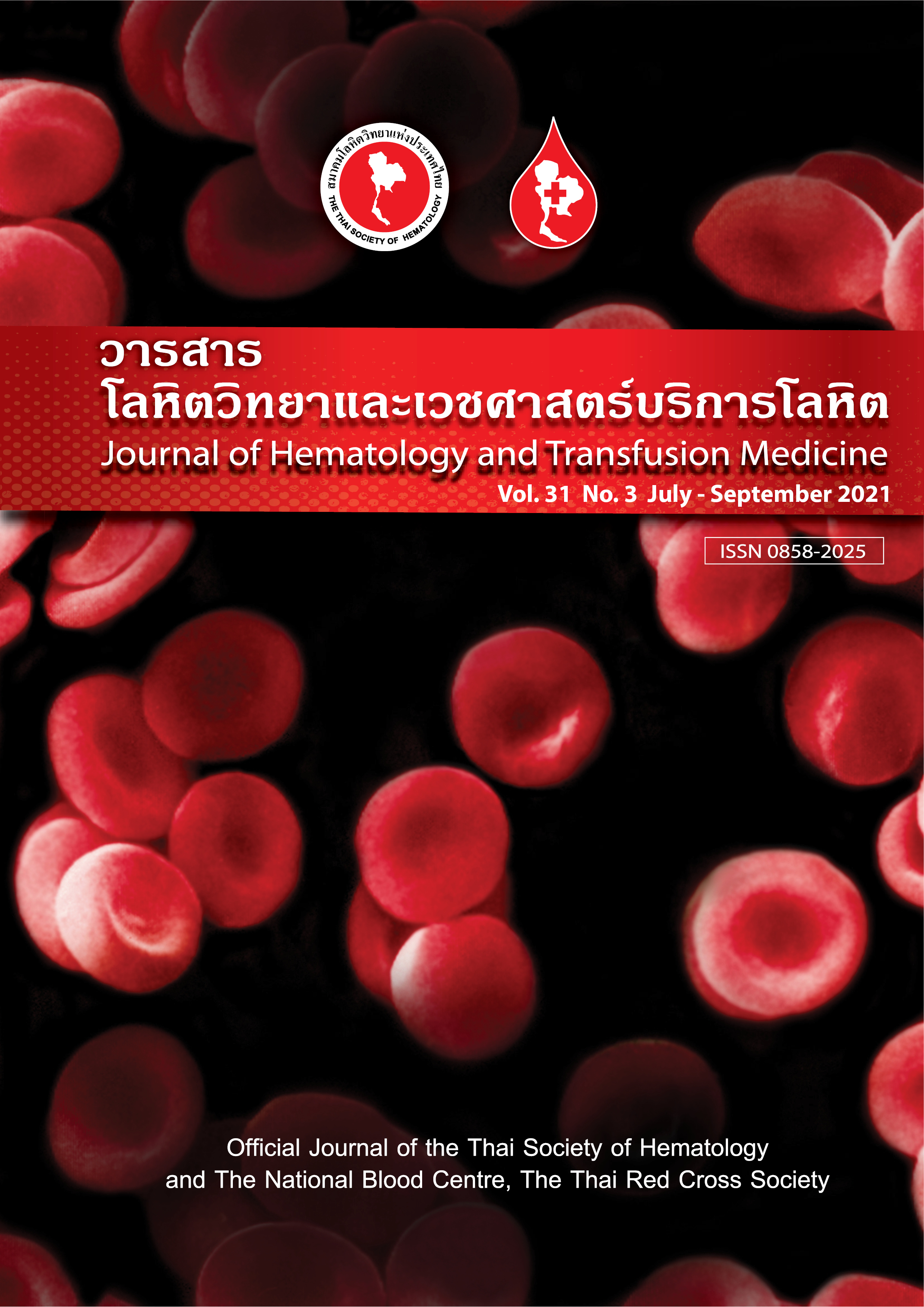External proficiency testing in HLA typing for kidney transplantation in Thailand from 2009 to 2020
Keywords:
HLA typing, Proficiency testing, Kidney transplantationAbstract
Abstract:
Introduction: HLA-A, -B, and -DRB1 typing between donors and patients is important in deceased donor kidney transplantation. The Organ Donation Centre and the National Blood Centre, Thai Red Cross Society, have conducted national proficiency testing to assess the laboratory performance of HLA typing and to verify the accuracy and reliability of test results since 2001. Objective: This retrospective study aimed to analyze the performance and improvement of HLA typing among participating laboratories from 2009 to 2020. Materials and Methods: From 2009 to 2020, 96 blood samples were sent to 9 participating laboratories requested to perform HLA-A, -B, and -DRB1 typing using routine reagents and techniques. The HLA typing results were returned, compiled and assessed. A summary of the HLA antigens was obtained from the results reported by 3 reference laboratories and confirmed by DNA sequencing. Discrepant typing results from each laboratory were analyzed. Results: The most common errors were found in HLA-B typing (9.89%), followed by HLA-A (5.73%), and HLA-DRB1 typing (5.73%). The discrepant results frequently occurred in the HLA-B*15 allele group (B62 and B75); A*11, A*69 and DRB1*14, due to their high polymorphism compared with other HLA alleles. From the years 2018 to 2020, correct HLA-A, -B, and -DRB1 typing results were obtained from all laboratories confirming the gradual improvement of laboratory performance during this study period. Conclusion: Participation in the national proficiency testing in HLA typing would be useful to assess laboratory performance and improvement. This could ensure that laboratory performance remains reliable and accurate among different laboratories in Thailand.
บทคัดย่อ
บทนำ การตรวจชนิดของ HLA-A, -B และ -DRB1 ระหว่างผู้บริจาคไตและผู้ป่วยมีความสำคัญในการปลูกถ่ายไตจากผู้บริจาคไตสมองตาย ศูนย์รับบริจาคอวัยวะและศูนย์บริการโลหิตแห่งชาติ สภากาชาดไทย ได้เริ่มดำเนินโครงการการทดสอบความชำนาญของการตรวจ HLA เพื่อประเมินประสิทธิภาพห้องปฏิบัติการ และเพื่อตรวจสอบความถูกต้องและความน่าเชื่อถือของผลการทดสอบตั้งแต่ปี พ.ศ. 2544 วัตถุประสงค์ การศึกษาย้อนหลังนี้มีวัตถุประสงค์เพื่อวิเคราะห์ประสิทธิภาพและการปรับปรุงการตรวจ HLA ในห้องปฏิบัติการที่เข้าร่วมโครงการตั้งแต่ปี พ.ศ. 2552 ถึง พ.ศ. 2563 วัสดุและวิธีการ ตั้งแต่ปี พ.ศ. 2552 ถึง พ.ศ. 2563 ได้ส่งตัวอย่างเลือดจำนวน 96 ตัวอย่างไปยังห้องปฏิบัติการที่เข้าร่วมโครงการ 9 แห่ง โดยให้ตรวจ HLA-A, -B และ -DRB1 โดยใช้น้ำยาและเทคนิคที่ใช้ในงานตรวจประจำ ได้รวบรวมผลการตรวจ HLA ที่ส่งกลับและประเมินสรุปชนิดแอนติเจนของ HLA ที่ได้จากผลที่รายงานโดยห้องปฏิบัติการอ้างอิงสามแห่งและตรวจยืนยันโดยการหาลำดับดีเอ็นเอ อีกทั้งทำการวิเคราะห์ผลการตรวจที่ผิดพลาดจากแต่ละห้องปฏิบัติการ ผลการศึกษา ข้อผิดพลาดที่พบบ่อยที่สุดคือ การตรวจ HLA-B (9.89%) ตามด้วย HLA-A (5.73%) และ HLA-DRB1 (5.73%) ผลตรวจแอนติเจนที่ไม่ตรงกันส่วนใหญ่พบในกลุ่มอัลลีล HLA-B * 15 (B62 และ B75); A*11, A*69 และ DRB1*14 เนื่องจากมีความหลากหลายสูงเมื่อเทียบกับอัลลีลของ HLA ชนิดอื่น ตั้งแต่ปี พ.ศ. 2561 ถึง พ.ศ. 2563 ผลการตรวจ HLA-A, -B และ -DRB1 จากห้องปฏิบัติการให้ผลถูกต้องทั้งหมด ซึ่งช่วยยืนยันการปรับปรุงประสิทธิภาพของห้องปฏิบัติการอย่างต่อเนื่องในช่วงการศึกษานี้ สรุป การมีส่วนร่วมในการทดสอบความชำนาญระดับชาติในการตรวจ HLA จะเป็นประโยชน์ในการประเมินประสิทธิภาพและการปรับปรุงห้องปฏิบัติการ เพื่อให้มั่นใจได้ว่า การตรวจของห้องปฏิบัติการในประเทศไทย มีประสิทธิภาพ มีความน่าเชื่อถือและมีความแม่นยำ
Downloads
References
O-Charoen R, Kupatawintu P. Selection criteria for transplantation. In: Jirasiridham S, editor. Textbook of kidney donation for transplantation. Bangkok: Krungthepvejchasarn; 2001. p. 14-21.
The OPTN/UNOS Histocompatibility Committee. Specimens for histocompatibility testing guidelines for OPOs. [cited on 16 April 2021] Available from: https://unos.org/wp-content/uploads/unos/Histo_Brochure.pdf.
Doxiadis II, Claas FH. The short story of HLA and its methods. Dev Ophthalmol. 2003;36:5-11.
Vaughan RW. PCR-SSO typing for HLA-DRB alleles. Eur J Immunogenet. 1991;18:69-80.
Kupatawintu P, Pheancharoen S, Srisuddee A, Tanaka H, Tadokoro K, Nathalang O. HLA-A, -B, -DR haplotype frequencies in the Thai stem cell donor registry. Tissue Antigens. 2010;75:730-6.
Olerup O, Zetterquist H. HLA‐DR by PCR amplification with sequence specific primers (PCR‐SSP) in 2 hours: an alternative to serological DR typing in clinical practice including donor‐recipient matching in cadaveric transplantation. Tissue Antigens. 1992;39:225-35.
Schaffer M, Olerup O. HLA‐AB typing by polymerase-chain reaction with sequence‐specific primers: more accurate, less errors, and increased resolution compared to serological typing. Tissue Antigens. 2001;58:299-306.
Tupmongkol T, Kanunthong S, Boonpokkrong P, Tatawatorn A, Nathalang O, Attajarusit Y, et al. Implementation of real-time PCR for HLA typing in deceased donors. J Hematol Transfus Med. 2017;27:217-24.
Eisenbrey III AB, Kopko PM. The HLA system. In: Fung MK, Eder AF, Spitalnik SL, Westhoff CM, editors. Technical manual. 19thed. Bethesda: American Association of Blood Banks; 2017. p 435-54.
Kupatawintu P. External quality assessment scheme in HLA in Thailand. Thai J Hematol Tranfus Med. 2004;14:163-9.
Marsh SG, Albert ED, Bodmer WF, Bontrop RE, Dupont B, Erlich HA, et al. Nomenclature for factors of the HLA system, 2010. Tissue Antigens. 2010;75:291-455.
Nomenclature for factors of the HLA system. [cited 18 May 2021]. Available from:
http://hla.alleles.org/nomenclature/index.html.
Madden K, Chabot-Richards D. HLA testing in the molecular diagnostic laboratory. Virchows Arch. 2019;474:139-47.
Dutra VF, Bub CB, Costa TH, Santos LD, Bastos EP, Aravechia MG, et al. Allele and haplotype frequencies of human platelet and leukocyte antigens in platelet donors. Einstein (Sao Paulo). 2019;17:eAO4477. doi: 10.31744/einstein_journal/2019AO4477.
Ounjai S, Ponraweethitikorn P, Kanunthong S, Srisuddee A Phiencharoen S, Kupatawintu P, et al. HLA-A, -B, and -DR frequencies in deceased kidney donors of the Organ Donation Centre, Thai Red Cross Society. J Hematol Transfus Med. 2019;29:175-81.
Puangpetch A, Koomdee N, Chamnanphol M, Jantararoungtong T, Santon S, Prommas S, et al. HLA-B allele and haplotype diversity among Thai patients identified by PCR-SSOP: evidence for high risk of drug-induced hypersensitivity. Front Genet. 2015;5:478. doi: 10.3389/fgene.2014.00478.
Bozón MV, Delgado JC, Turbay D, Salazar M, Granja CB, Alosco SM, Dupont B, Yunis EJ. Comparison of HLA-A antigen typing by serology with two polymerase chain reaction based DNA typing methods: implications for proficiency testing. Tissue Antigens. 1996;47:512-8.
Bozón MV, Delgado JC, Selvakumar A, Clavijo OP, Salazar M, Ohashi M, et al. Error rate for HLA-B antigen assignment by serology: implications for proficiency testing and utilization of DNA-based typing methods. Tissue Antigens. 1997;50:387-94.



